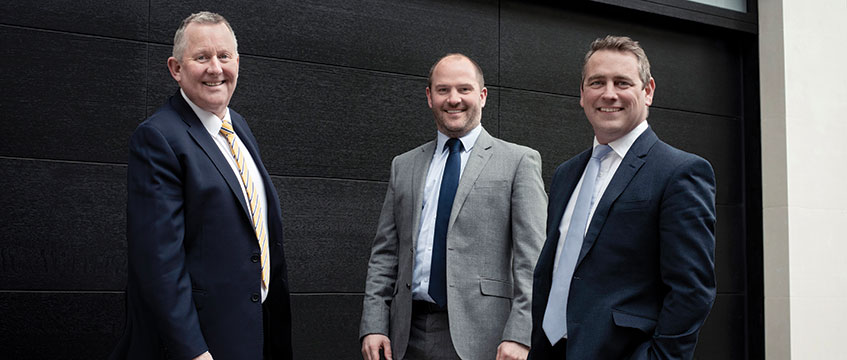Montreaux: thinking inside the big box
In a quiet Mayfair office, Montreaux’s three-man investment team debates the future of big-box retail.
“There is always going to be demand for retail parks,” says managing director Damian Stalley. “But there will be fewer and with stronger brands. Some of the more secondary ones will be repositioned and they are the opportunities we are looking at.”
Stalley spent seven years at St James’s Investments, where he specialised in retail-led town centre regeneration, working alongside Tesco. With Montreaux he has changed tack, looking at how residential development can breathe life into old retail parks.
In a quiet Mayfair office, Montreaux’s three-man investment team debates the future of big-box retail.
“There is always going to be demand for retail parks,” says managing director Damian Stalley. “But there will be fewer and with stronger brands. Some of the more secondary ones will be repositioned and they are the opportunities we are looking at.”
Stalley spent seven years at St James’s Investments, where he specialised in retail-led town centre regeneration, working alongside Tesco. With Montreaux he has changed tack, looking at how residential development can breathe life into old retail parks.
The developer recently added a 6.8-acre B&Q site at Broadway Retail Park in Cricklewood, north-west London, to its growing portfolio of residential-led mixed-use regeneration, and the team is on the lookout for more opportunities of this sort.
“There are better uses for that land, particularly in the more urban areas,” adds chief executive David Burke. He started out in property more than 30 years ago, working in pubs and retail asset management and later launching his own resi-led mixed-use start-ups.
Executive director and former Strutt & Parker partner Matt Tack jumps in: “We are being contacted by institutions specifically in relation to well-connected retail parks and shopping centres. That’s a natural source of future sites for us.
“We own retail parks that are operational now but we can see the leases expiring and we are looking at asset management to maximise value.”
Montreaux spent £200m on land acquisitions in 2018, £100m in the first quarter of 2019, and the team has just signed off another £500m – a combination of UK and international pension funds, insurance companies and institutional investment.
In the old days developers used to refer to commercial and residential as oil and water – they didn’t mix well
It currently has 8,000 homes in planning or under development, with land for around 3,000 more under offer, and it expects to hit 15,000 by the end of the year.
Montreaux started out with Burke and Stalley in a small Staines-based operation in 2014. They focused on sites in London with around 30 units, turning around a maximum of 150 homes a year.
Fast-forward to 2019 and there are around 50 employees with schemes comprising around 1,000 homes, as well as the commercial arm to the business. It has, however, retained the agility of a small leadership team.
“When we see a site, our USP is that we can move very quickly. The guys around this table make the decisions, we don’t have a third party to go to,” says Burke. This means that Montreaux can turn around a multi-million-pound deal in days.
This isn’t just the snappy acquisition process, but planning and consultancy too, explains Tack.
Big ambition
Montreaux’s £1bn Margarine Works development in Southall, west London, is case in point.
The team was able to unlock the site of the world’s largest producer of margarine with a proposal for a high-density residential scheme of 2,000 homes which was approved by Ealing Council in just six months.
The scheme, designed by Assael Architects, has a mix of for-sale and build-to-rent homes, and 35% affordable housing.
“The big priorities were affordable housing and they actually just wanted to see the site redeveloped,” says Stalley.
“A lot of people had spoken about redeveloping the site and never brought it forward and that was one of the main concerns,” adds Burke.
Montreaux bought the site for £76m in 2017 from 85-year-old owner Michael J Hunt and Hovedean Properties. Hunt had owned the site since 1989 and the council had been approached several times by developers seeking to build it out, none of which were successful.
Burke knew the vendor – “a canny individual”, he says – and the team was persistent and ambitious: doubling the housing provision to increase viability and buy the land at a higher rate.
Location, location, location
What does Montreaux look for? “Scale, placemaking, geography,” says Tack. The sites tend to be bound within the M25 and old industrial parks close to train stations with high residential demand.
It means schemes such as the Toys R Us site on Old Kent Road, SE1, don’t appeal to the company (though it did look at it very seriously), while the 6.8-acre B&Q site opposite Cricklewood train station is a perfect match.
“That will be a true mixed-use scheme with residential, build-to-rent, possibly some student and retail,” says Burke.
B&Q has two years left on the lease and it hopes to retain a small space for a scaled-down Tesco Express-style retail offering in line with its shift to high-street stores in place of huge warehouses.
While retail parks are in decline, a solid commercial offering is still a vital part of mixed-use schemes, and that commercial background gives Montreaux an edge over the housebuilders.
“For years and years, developers have been trying to get a relationship between commercial and residential. In the old days they used to refer to them as oil and water – they didn’t mix well,” says Burke. But, this has shifted and the rise of build-to-rent now means residential development has become a longer game, with investors looking for steady returns, planning 40-50 years down the line.
A rapid succession of acquisitions means Montreaux has housebuilders, developers and build-to-rent operators banging at its door, on top of those institutional landlords selling out of retail.
“The one thing they lack is the actual product to develop out. They seem to have either access to money, or a great platform. They don’t have the land on which to develop the sites, though,” says Burke.
The connectedness of Montreaux’s sites makes them ripe for build-to-rent development. “That was a conscious decision,” says Stalley. “We want to be in great locations where there is high demand from the rental and sales market.”
Montreaux is in discussions with financiers to set up its own build-to-rent fund and is exploring options for third-party management.
It de-risks by including different tenures alongside that fine-tuned commercial offering and public uses.
In Ilford, Essex, the primary school is central to the regeneration, while in Southall there’s leisure uses and restaurants (including Prince Charles’s so-called favourite takeaway Brilliant Restaurant, with a training school) and in Cricklewood, retail is still high on the agenda, just a slimmed-down version.
However, expansion for Montreaux is not through including different uses. The team is seeking to broaden beyond the M25: Cambridge, Oxford, Bristol, Manchester and Birmingham are all on the hit list, with deals set for announcement any day now.
The Mayfair office is a recent addition, too. They moved in last week, a sign that business is going well.
To send feedback, e-mail emma.rosser@egi.co.uk or tweet @EmmaARosser or @estatesgazette











